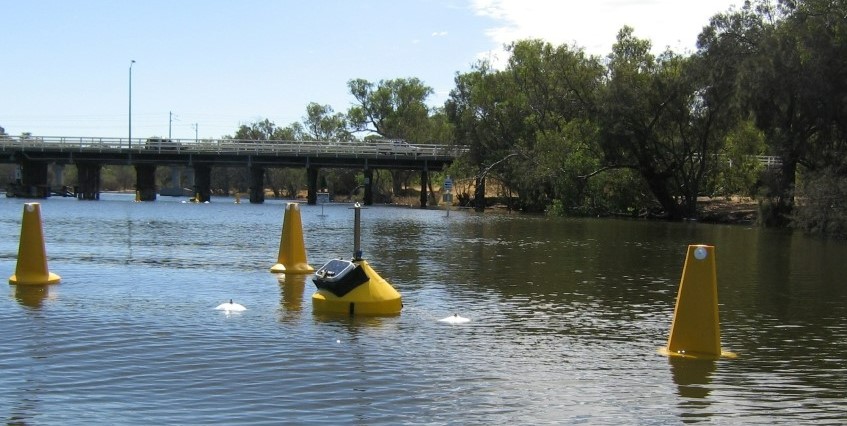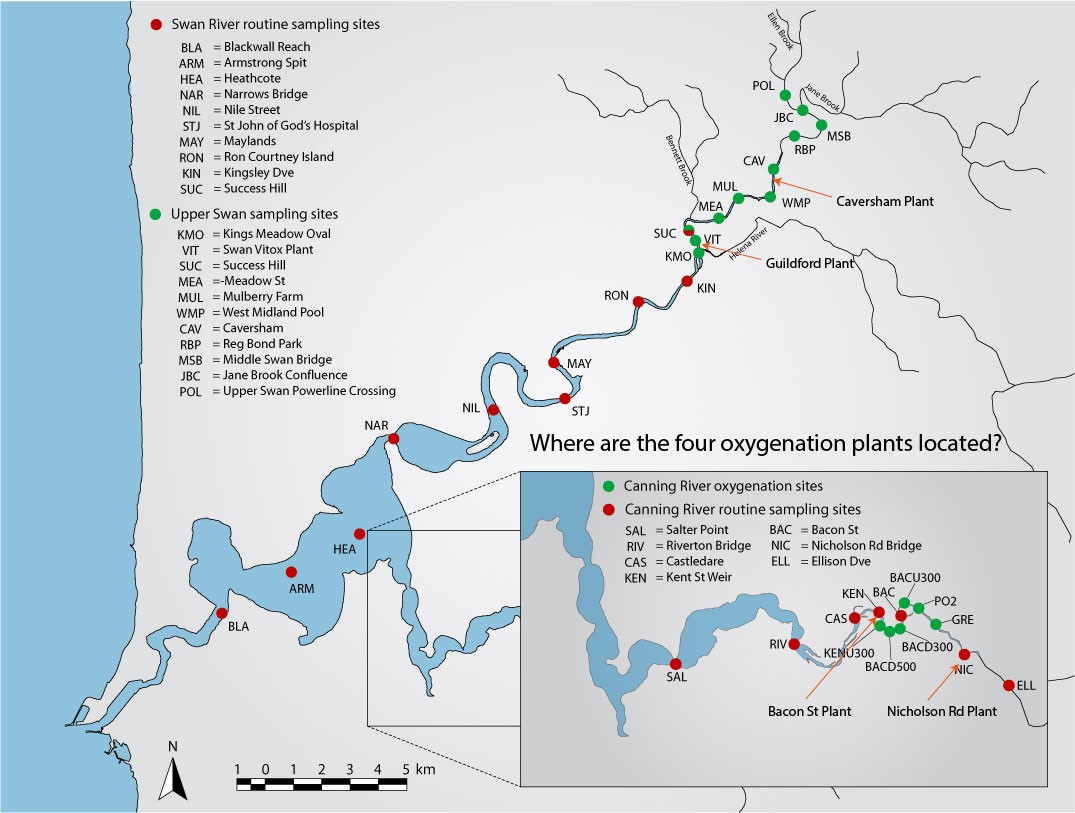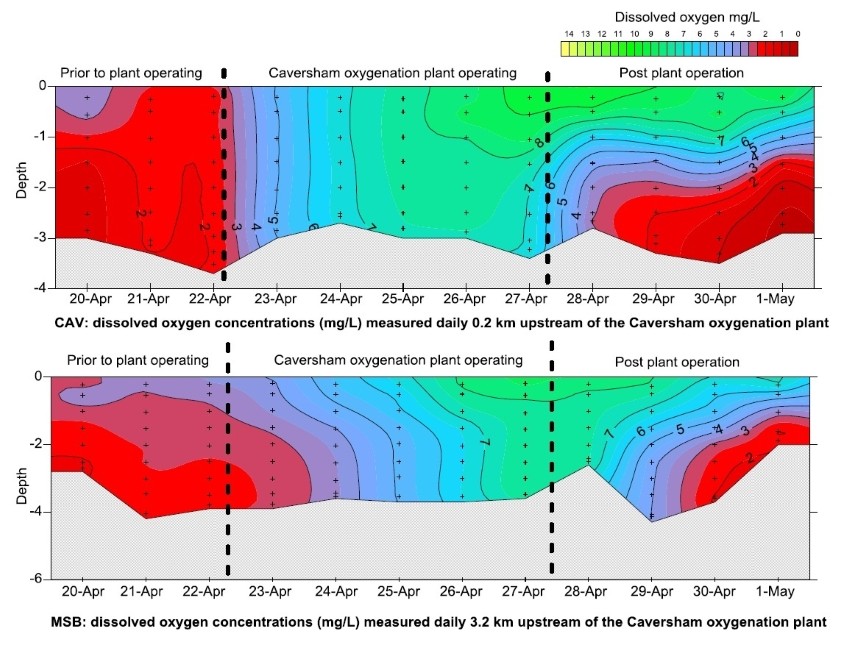Low dissolved oxygen
Low oxygen concentrations is a symptom of excessive nutrients entering waterways from surrounding urban and agricultural land - a process known as eutrophication. Excessive nutrients can accelerate the growth of aquatic plants and algae, which consume oxygen over-night when they respire, as well as through degradation processes when they die. Oxygen is also consumed by chemical reactions occurring in the top layers of the sediment.
Oxygen is naturally replenished by transfer from the overlying air, mixing (via wind or flow) and the photosynthesis of aquatic plants and algae during the day. However, in highly eutrophic systems, oxygen is consumed faster than it is replenished, and concentrations decline, sometimes to the point the water body is completely devoid of oxygen.
Oxygen is essential for most aquatic life. Low dissolved oxygen impacts on the healthy functioning of the ecosystem and may cause acute stress and death (fish kills).
Artificial oxygenation
The Department of Water and Environmental Regulation began trialling artificial oxygenation to supplement excessive oxygen demands and mitigate the symptoms of low oxygen in 1998–1999 both with a land-based plant on the Canning and a barge-mounted plant on the Swan.
The success of trials led to artificial oxygenation becoming a long-term management tool for the Swan-Canning estuary. Four oxygenation plants are now managed and operated by Department of Biodiversity, Conservation and Attractions, two on the upper Swan at Guildford and Caversham, and two on the Canning River above the Kent St weir at Bacon St and Nicholson Rd.
Artificial oxygenation provides a refuge for aquatic animals and promotes healthy ecological processes to break down organic matter and recycle nutrients, which in turn enhances the public amenity by reducing unpleasant odours and the occurrence of nuisance algal blooms (this link needs updating to new content on wa.gov.au).
Oxygenating rivers and estuaries for environmental outcomes is novel and highly specialised; there are only a handful of other examples worldwide. The oxygenation plants utilise concepts and technologies developed for other applications, such as improving water quality in stratified reservoirs.
When designing the oxygenation plants on the Swan and Canning rivers, traditional approaches needed to be adapted to work in shallow, warm and in the case of the Swan River, seasonally saline water bodies. Side stream super-saturation (SSS) was chosen because it is not dependent upon extended contact time between oxygen bubbles and the water column. Water is pumped from the river to the land-based plant and dissolved oxygen in increased to very high concentrations under pressure (supersaturation). The oxygen-rich water is returned to the river via distribution pipes, and rapidly diluted and dispersed up and downstream.
The response of the river to the operation of the plants is monitored in real time via telemetered instruments. The Department of Biodiversity, Conservation and Attractions undertakes weekly physical profiling of the water column. Operational regimes and oxygen delivery rates of the plants are adjusted to ensure that dissolved oxygen concentrations are maintained at optimal levels to support aquatic life.
We assessed the effectiveness of the plants via experimental studies and modelling. You can read more about these assessments in:
- Modelling the effectiveness of artificial oxygenation in the Swan-Canning estuary
- Oxygenating the Canning River
- Artificially oxygenating the Swan River estuary increases dissolved oxygen concentrations in the water and at the sediment interface (Science Direct 2018)
The plants were shown to maintain adequate oxygen concentrations in the both the upper Swan River estuary and the Canning River, upstream of the Kent St weir. Without operation of the oxygenation plants, hypoxic conditions would prevail for long periods.
For example, water column profiling before, during and after operation of the Caversham plant demonstrated that dissolved oxygen concentrations increased incrementally each day until the plant was turned off, from which point oxygen concentrations declined rapidly. The impact of artificial oxygenation was largest at monitoring sites close to the plant (e.g. Caversham, CAV, 0.2 km upstream), but sites further away were also affected (e.g. Middle Swan Bridge, MSB, 3.2 km upstream).
A smaller scale trial was undertaken in the Vasse estuary in the summers of 2015–16 and 2016–17 to assess if artificially oxygenating the Vasse exit channel was a viable option for improving water quality upstream of the surge barrier.
The trial used a lower capacity, but more easily deployed, oxygenation technology. Two BOC Solvox drop-in units were deployed at two locations upstream of the surge barrier. The drop-in units contained a submersible pump, an oxygen dissolver, and outlets to disperse the highly oxygenated water into the surrounding water. Power and oxygen were piped to the units from a temporary land-based plant. Each unit was programmed to turn on when dissolved oxygen dropped below 4 mg/L and off when it exceeded 6 or 8 mg/L.
For much of the trial period, the oxygenation plant was able to maintain adequate dissolved oxygen concentrations in the trial area 470 m upstream of the surge barrier. When exceptionally large algal blooms were present, the capacity of the plant was inadequate to counter the rapid drawdown of oxygen when the algae were respiring (generally in the early hours of the morning).
Artificial oxygenation is one of a suite of innovative remediation tools we have tested or applied to improve water quality. Other approaches are being explored as part of Heathy Estuaries WA.
Publications
- Oxygenating the Canning River
- Oxygenating the Swan and Canning rivers
- Oxygenating the Vasse estuary exit channel
- Report on the 1999–2000 Canning River oxygenation project
- Report on the 1999–2000 Swan barge oxygenation trial
- 1998–1999 Canning River oxygenation trial






